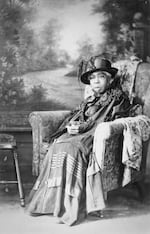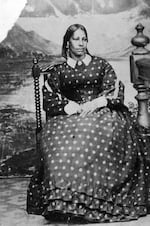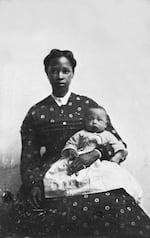For decades, Oregon legally excluded Black people from settling in the region. Despite racist laws and attitudes, some came anyway.
“Oregon’s Black Pioneers” examines the earliest African-Americans who lived and worked in the region during the mid-1800s. They came as sailors, gold miners, farmers and slaves. Their numbers were small, by some estimates just 60 Black residents in 1850, but they managed to create communities, and in some cases, take on racist laws — and win.

Mary Jane Shipley Drake, resident of Benton County
Photo Courtesy of Oregon Historical Society, Orhi 89474
The earliest known person of African descent was Markus Lopeus, a Black sailor who arrived at Tillamook Bay with merchant sea captain Robert Gray in 1788. It is documented that Lopeus died during a dispute with local Native Americans. In the following years, Black fur trappers and explorers came to the region. Many worked for the Hudson’s Bay Company. A few led some of the first emigrant wagon trains over the Oregon Trail. But as more and more white settlers arrived in the area, they brought their own laws and prejudices with them.
“— Walidah Imarisha, educator and writerThe entire region of the Northwest… criminalized the presence of black people and the first black Exclusion Law included the Lash Law that said black people would be publicly whipped every six months until they left the territory.”
In the 1840s, the region’s provisional government forbid slavery, while also banning Black people from settling in the area. When Oregon became a state in 1859, it was the only state admitted to the Union with an Exclusion Law in its constitution. That law remained until voters removed it in 1926, while the original racist language stayed on the books until 2002.
“Oregon’s Black Pioneers” explores the stories of the African-Americans who lived, worked and created communities despite the hardships. People like Robin and Polly Holmes, who sued their former owner for their children’s freedom; Letitia Carson, who successfully took a wealthy landowner to court after he stole her property; and James Douglas, who spent twenty years helping run Fort Vancouver before becoming the governor of Vancouver Island and British Columbia.
“— Gwen Carr, Oregon Black Pioneers organizationIn spite of these laws which continued on the books on and off in various manners, you had blacks living all over the state. It's very interesting finding out who they came with, how they got here, what did they do, did they stay, did they leave, did they marry? All of these are pieces of a puzzle. You find little pieces and then you add on another piece and, before you know it, you have a real picture of what it was like to be black in Oregon prior to the 1900s.”
Using rare historical photographs, primary documents and expert interviews, this half-hour documentary examines the little-known history of Oregon’s Black pioneers.
Resources and Information
Websites
- Oregon Black Pioneers
- Oregon Historical Society
- Oregon State Archives -- Black in Oregon
- Letitia Carson Historical Website
- End of the Oregon Trail
- Black Past
Books
- Coleman, Kenneth R. 2017 Dangerous Subjects: James D. Saules and the Rise of Black Exclusion in Oregon.
- Kirkpatrick, Jane, 2014 A Light in the Wilderness.
- Margolin, Phillip, 2014 Worthy Brown's Daughter.
- McFetridge, Timothy C., 2017 Rachel's Son Jackson.
- McLagan, Elizabeth, 1980 A Peculiar Paradise: a History of Blacks in Oregon, 1788-1940.
- Meranda, Janet F., 2016 Freedom's Light: The Letita Carson Story Begins.
- Meranda, Janet F. Oregon Trail Diary: Letitia Carson, 1845.
- Nokes, Gregory R., 2018 The Troubled Life of Peter Burnett: Oregon Pioneer and First Governor of Oregon.
- Nokes, Gregory R., 2014 Breaking Chains: Slavery on Trial in the Oregon Territory.
- Oregon Black Pioneers and Moreland, Kimberly Stowers, 2013 Images of African Americans of Portland.
- Taylor, Quintard, 1998 In Search of the Racial Frontier: African American in the American West 1528-1990.


